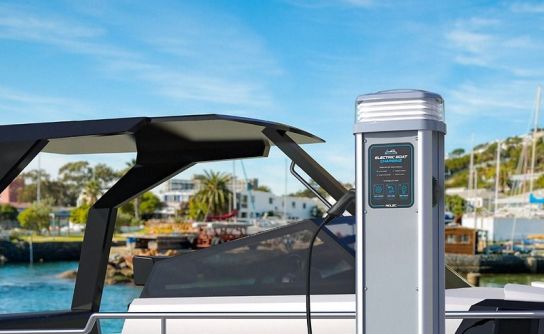5 September 2024
Rolec has been designing and manufacturing outdoor electrical equipment for over three decades, and has been on the forefront of technological advancements at every junction. Its work with the boating sector has been no different, leading to the development of a vast range of waterside electrical, sanitation and emergency services equipment, bespoke to the needs of any marina.
Within this range of products sits the collection of charging solutions for electric boats and cars. The former of which, Rolec will be diving into in this piece.
Electric Boat Charging Through the Years
Similar to the developments in EV car charging over the last 50 years, electric boat charging has welcomed some exciting new technology that has already improved the overall user experience. Increased battery storage, increased automation, and developments to motor technology to name a few. As a result, there have also been advances in charging technology.
Where there was once only AC, 3-pin charging, there are now high-powered fast DC chargers with the capacity to produce up to 360kW of power direct to your boat. Which, paired with advances in battery technology, has revolutionised the boating industry’s capacity to provide green vehicles.
Furthermore, developments in battery management software have allowed for increased visibility over your charging network and advanced real-time user data. Allowing operators to prioritise charging for certain boats, monitor charging status in real-time and adjust the distribution of site electricity all on one integrated platform.
Not to mention the environmental benefits of making the oceans green. As a society we have seen vast improvements in lowering ocean pollution, through national beach clean ups, investment in offshore wind and much more. And electric boating is one of the newest initiatives symbolising a change in tides for carbon reduction.
AC vs. DC Charging (Charging Times and Cost)
When deciding on a charging solution that suits your needs, it is important to understand the key differences between AC and DC charging.
Notably, the main distinction between the two is charging speed. AC charging is, by nature, slower at filling your batteries than DC charging. However, the decision on what to choose is more nuanced than just speed.
AC charging, for example, is championed as the more battery-friendly option for electric boat charging, due to its gentler approach to electrification. On average, an AC charger can take between 8-10 hours to provide a full charge, and as such is best suited for overnight charging. Or for boat owners who are setting out on the water less often or at a much slower pace.
They are also the more cost-effective option, both in unit price and electrical usage. The electrical draw of an AC charger being significantly lower than their DC counterparts means that charging hardware doesn’t need to be as substantial, saving space and money. Additionally, overnight charging also allows the user to take advantage of favourable electricity tariffs. Translating to an overall cost-saving for the user.
DC charging, however, is most recognisable for its rapid charging speeds. Comparatively, a DC chargepoint could provide an 80% charge in as little as 20 minutes, and an average of between 20-60 minutes. The benefits for boating rental agencies, larger vessels, and more frequent users (such as water taxis) are clear - a reduction in boat downtime. They are also fully configurable, upgradable, and scalable to meet any of your marina’s needs now and in the future.
With this considered, for most electric boaters an overnight AC charger is sufficient. However, for the keener skippers amongst you, a combination of AC fast charging with ad hoc DC rapid top-ups is a great option. Think, AC for need and DC for speed.
Finding the Right Charging Station for You
Now that you have a clearer idea of whether AC or DC charging is the right fit for you, it is time to start considering what other features you are looking for in your electric boat charge points.
Considerations such as durability, accessibility, and aesthetics, are likely to make up a large part of your decision. For example, the unit needs to be able to withstand the daily wear and tear present at a waterside location where weather is unpredictable, and traffic may be high. For this reason, it is important to look for units manufactured with more durable materials, like aluminium and steel, that are industry tested in combination with a generous warranty and maintenance policy.
It is also important to consider how charging hardware will work within your marina network. Both aesthetically and in relation to accessibility. Features such as built-in LED amenity lighting, therefore, will not only fit the overall look and feel of your waterside location, but also provide a pivotal function in increasing unit visibility.
At Rolec, our dedicated marina team consists of industry experts and engineers that are available just a phone call away, poised to offer you project support and advice at any point in your electrification journey. Combined with our 30+ years of experience in the industry, it is one of the many reasons that we have become a globally trusted marina supplier.
For more information on electrifying your marina, contact the marina team at: rolec@rolecserv.co.uk

